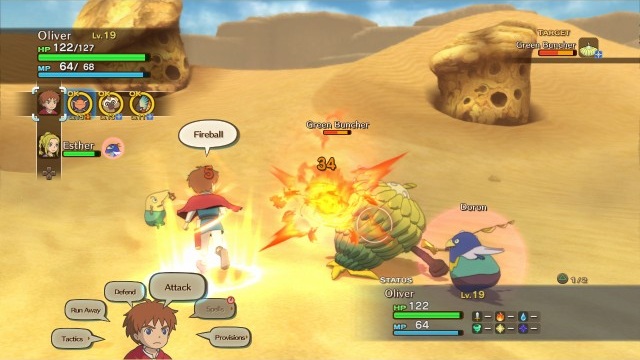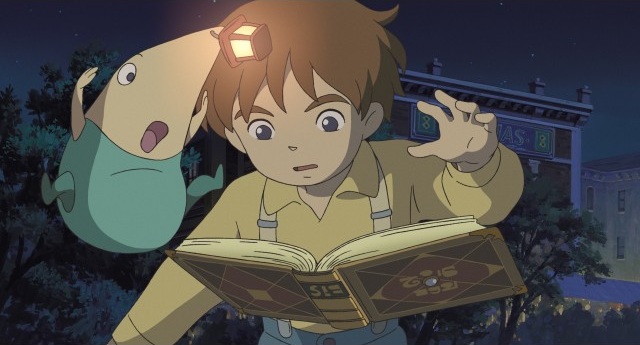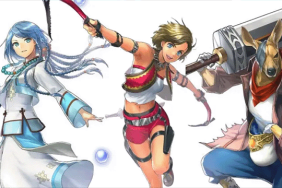Hayao Miyazaki would be proud.
Ni No Kuni is a clean, wholesome, uncomplicated love letter to the golden age of Japanese RPGs, to a time when sprite-based adventures across sprawling world maps and epic dungeons held supreme. In a certain light, it's surprising to see the need for such a letter, but nearing the end of the PlayStation 2, the traditional single-player JRPG fell out of favor. The global rise of MMORPGs, the advent of open-world Western RPGs and darker-themed JRPGs like Shin Megami Tensei, and the saturation of JRPGs themselves during the era led to a developmental shift, illustrated by the popular Final Fantasy series as it moved beyond Final Fantasy X to its more recent downfall with Final Fantasy XIV Online. The classic JRPG is in dire need of a revival, and Ni no Kuni is the phoenix down.
Joining forces with renowned animation house Studio Ghibli, developer Level-5 has channeled their experience with Rogue Galaxy and Dragon Quest VIII in creating the light-hearted story and environments of Ni No Kuni. Fans of the Dragon Quest series and Studio Ghibli's prior feature films like Princess Mononoke and Spirited Away will find familiar elements in abundance: characters with rounded faces, panoramic landscapes with a healthy variety of saturated colors, a sweeping orchestral soundtrack, adorable creatures with only two bright eyes for a face, and a journey that spans in traditional order from plains to forests, deserts, mountains, and islands. The cut-scenes crafted by Studio Ghibli, while few and far between, are breathtaking to watch.
Though based in classical mythology and common JRPG themes, Ni No Kuni has one defining characteristic that separates itself from other stories: a boy sorcerer. The vast majority of adventures featuring a male hero, in literature but especially in video games, typically follow the structure of a warrior coming of age. The choice of the magically gifted child Oliver as the protagonist allows the story not only to fit the suitable E10 rating, but also to detach itself enough from the sword-and-shield trope so that it can more readily explore gentler emotional themes.
At its heart, Oliver's journey is about a child who must cope with loss and innocence. Raised by a single mother in the swell town of Motorville, he has a perfectly pleasant upbringing and sees no trouble taking interest in his best friend's pursuit of building a car. Unfortunately, the jury-rigged heap of metal becomes faulty during a test run, leading his mother to sacrifice her life to save him.
After several days of mourning, he begins to shed tears on a raggedy doll who then suddenly transforms into Mr. Drippy, Lord High Lord of the Fairies, who explains that every person in Motorville has a soulmate in his world who is connected to each other through space and time. If Oliver is able to save Alicia from the evil clutches of Shadar, it might bring his mother back to life. The extent of character development isn't deeply profound here, but it's a simple story that warms the heart.
To defeat the dark sorcerer and restore peace to Mr. Drippy's world, Oliver must learn new spells by filling the pages of The Wizard's Compendium, which the player can browse at any time in the menu (or obtain in physical form through various offers like the Wizard's Edition). Each spell has a somatic movement that Oliver sometimes performs in a cut-scene, and many have a purpose in and out of battle. By the end of the main story, puny fireballs and frostbites will be effectively replaced by screen-clearing thunderstorms and terrifying summons. On the downside, many spells have no purpose beyond a single use, which somewhat clogs the interface, and some spells that are in The Wizard's Compendium have no function at all.

With powerful monsters roaming the countryside, Oliver can't survive on magic alone, which prompts Mr. Drippy to introduce him to the wizarding school of familiars. Similar to Pokémon, familiars can act in place of Oliver, have various forms of evolution, and can be captured on the field. Still, there's an important distinction—a familiar's health and mana is tied directly to Oliver's. This system in effect favors familiars with high stats in defense or with effective destruction and healing spells. Taking care of familiars by feeding them stat-improving treats and purchasing equipment is likewise key to survival.
The battle system combines the familiarity of Pokémon—pun intended—with real-time combat in a curious manner. Battles initiate when Oliver approaches a familiar on the field, with its back hopefully turned away, and combat begins once the player chooses Oliver, another player character, or any of their familiars. Selecting a melee option like attack or defend/evade will have the chosen character perform the action for a specific period of time out of the player control for movement. Luckily, the player can cancel any action and can pause the combat when selecting a spell or swapping characters.
However, there are more than several caveats that are both challenging and frustrating. Time doesn't stop while the player flips through commands, so if a boss has a devastating, fast attack, there may not be enough time to cancel the current action, send out an All-Defense command to the party, and move through the menu to the defend/evade option. Sometimes it's just impossible to protect the party from them, which leads to about ten seconds of healing… and then another devastating attack. A few bosses, the nightmares in particular, tend to cast these attacks one after another as if mana isn't a resource. And it doesn't matter whether you're on Easy or Normal.
The other party members not in the player's control act on their own, and while they're fairly safe in their attacks and defense, the range of directional orders is poor. Only a player character can assign tactics, which again takes time to select in the menu, and there only six general options assignable. Worse, the tactics menu is not selectable outside of battle so the player will need to spend several seconds reassigning tactics at the beginning of the next battle.

But as long as the player doesn't get too flustered, no battle is overwhelmingly difficult unless the enemies in the area are well beyond the party's ability. Since running away from battle is oddly not an option, saving frequently and following the guiding hand of enemy level placement is the name of the game—an aspect JRPG fans are accustomed to. On my own complete playthrough, I only lost three times, mainly when facing a challenge for which I was under-leveled.
That said, taking on the numerous side quests is encouraged and removes some of the sting out of grinding. The easier quests involve Oliver's locket, which can store a trait of a character's heart, like enthusiasm and restraint. Finding a character with an excess trait and giving it to a character with a lack of that trait is the simplest way of earning merit stamps, currency that allows Oliver to earn passive bonuses in the form of merit awards.
The only trouble comes from some challenges that require the player to capture specific familiars, especially when it comes down to a random chance. Defeated familiars have a low probability of becoming available for taming, to the point where this can take anywhere from one battle to an infinite number of battles to complete. Some method of trading familiars or making the taming process more precise would have been a good idea.
Moreover, Oliver can also accept bounty hunts, participate in a series of stadium challenges, and spend time in a casino that luckily allows underage children. Suffice it to say, there's plenty to keep players busy, especially in the post-game which opens additional challenges and a hidden boss. Completing nearly all the tasks available before the end boss takes more than 50+ hours, well worth the price of admission.
Not only a fantastic JRPG in its own right, Ni No Kuni: The Wrath of the White Witch is perfect for anyone who has ever wished to live inside a Studio Ghibli film. It encapsulates the magical attunement of Howl's Moving Castle, the adorableness of My Neighbor Totoro, the errands of Kiki's Delivery Service, the epic journey of Princess Mononoke, and the otherworldly dimension of Spirited Away. Though not quite a full-fledged masterpiece, Ni No Kuni reminds the JRPG genre of the imagination it had in its youth—perhaps nothing is more important.
-
Revives the classic JRPG genre
-
Heartwarming story and characters
-
Sprawling, gorgeous environments
-
Sweeping soundtrack
-
Like being in a Studio Ghibli film
-
Plenty of sidequests, plus post-game content
-
Sometimes not enough time to defend/evade
-
Tactics menu buried in combat, not many AI options available
-
Capturing familiars based on random chance
-
Lots of animal puns







